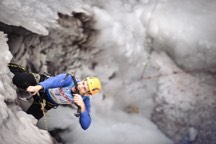Five Tips for New Ice Climbers
by Nathan Kutcher
More rock climbers are taking up ice climbing as a way of extending the climbing season and avoiding the burn-out that comes from another winter spent indoors pulling on plastic. And while ice climbing shares many skills and techniques with rock climbing, there are still a few specific tricks that can help ease the transition to the frozen world.
Here are five tips from one of Canada's top ice climbers that will help any new ice climber enjoy the upcoming season.
Keep your picks and front points sharp.
Not only do sharp points penetrate the ice more easily, but they also cause less fracturing. With sharp points you can also often just hook your tools (and step with your crampons) and they’ll bite into the ice when you weight them. This saves energy as you’re not swinging for placements or fighting to remove buried picks.
When you’re buying tools or crampons, make sure that you can easily find replacement picks and front points. This is also a good time to buy a few spare sets; there’s nothing worse than scrambling midseason to find new (or sometimes discontinued) picks.
Finally, take some time and learn the proper sharpening methods so you can get the best performance from your new tools.
Here are five tips from one of Canada's top ice climbers that will help any new ice climber enjoy the upcoming season.
Keep your picks and front points sharp.
Not only do sharp points penetrate the ice more easily, but they also cause less fracturing. With sharp points you can also often just hook your tools (and step with your crampons) and they’ll bite into the ice when you weight them. This saves energy as you’re not swinging for placements or fighting to remove buried picks.
When you’re buying tools or crampons, make sure that you can easily find replacement picks and front points. This is also a good time to buy a few spare sets; there’s nothing worse than scrambling midseason to find new (or sometimes discontinued) picks.
Finally, take some time and learn the proper sharpening methods so you can get the best performance from your new tools.
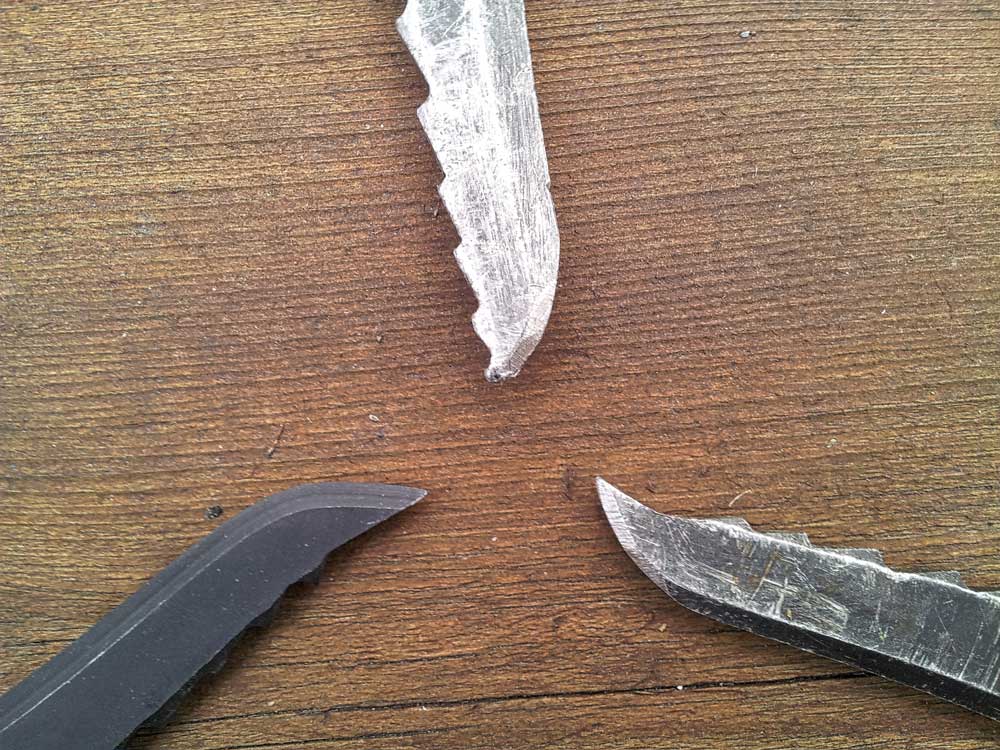
Life cycle of an ice pick - new, beat-up, resharpened.
Use the best tools for the job.
The best tool is not always the most expensive or the most hyped. Almost everyone gushes over high-end ice tools, but unless you’re climbing WI5 or doing steep drytooling, the less expensive tools often work as well or better than their pricier cousins. If you’re climbing lower angle ice or alpine climbing, there’s little need for fancy multi-handled tools. When you’re pounding pins, beating an ice hook into frozen mud or using an adze to chop through rotten ice, you’ll be happy to have a tool with a straighter shaft and a handle that you can you easily hold when the tool is reversed. I own several sets of tools and take the appropriate model for the type of climbing I plan to do that day.
The best tool is not always the most expensive or the most hyped. Almost everyone gushes over high-end ice tools, but unless you’re climbing WI5 or doing steep drytooling, the less expensive tools often work as well or better than their pricier cousins. If you’re climbing lower angle ice or alpine climbing, there’s little need for fancy multi-handled tools. When you’re pounding pins, beating an ice hook into frozen mud or using an adze to chop through rotten ice, you’ll be happy to have a tool with a straighter shaft and a handle that you can you easily hold when the tool is reversed. I own several sets of tools and take the appropriate model for the type of climbing I plan to do that day.
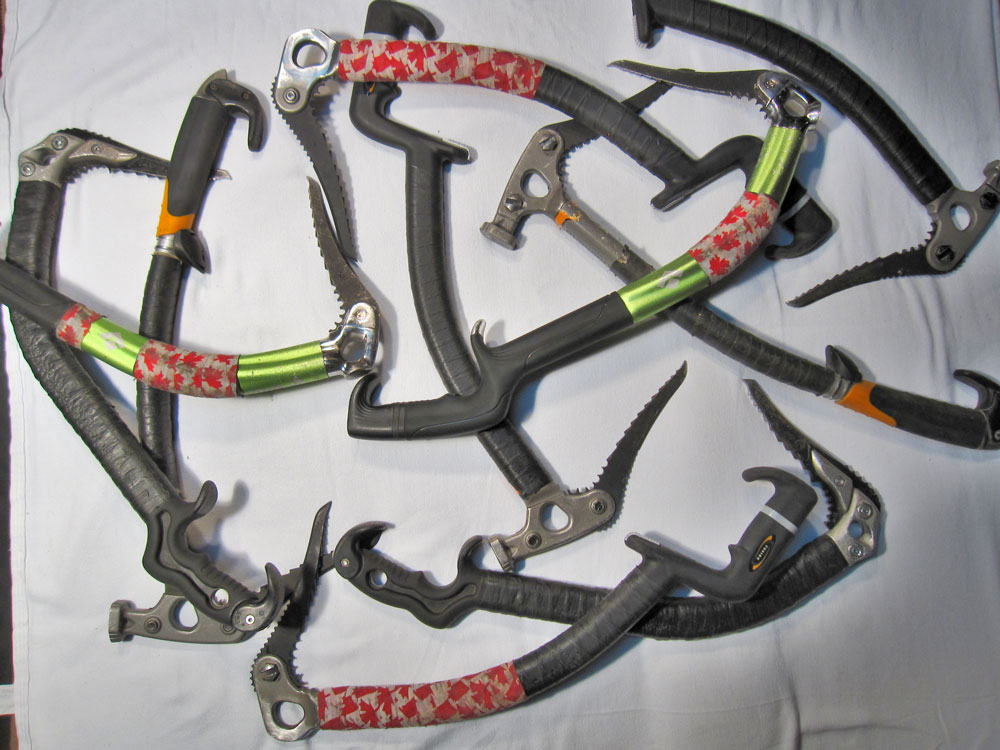
Use the right tools for the job.
Monopoint VS Dualpoint
Monopoint crampons are almost always a liability when climbing ice. And while you might not look as cool, you should consider using dualpoints on your crampons. When mixed climbing, I have often cursed monos after transitioning onto the ice. For pure ice or easy mixed, I almost always take a set of dualpoint crampons.
Dual front points offer more stability and hold better in bad ice. Climbers often claim they want monos so they can use pick holes for crampon placements. In theory this sounds great, but in practice it just doesn't work. I rarely find that my feet are properly positioned when I’m only using old pick holes. These same climbers also believe that monos offer better penetration in hard ice. Again, this has not been my experience. Hard ice often dinner-plates when you’re trying to get a pick placement, which creates great footholds for dual points. You also need to remember that front points don't need the same penetration that picks require. As long as you keep them sharp (see my first tip) dualpoints will work just fine even in bullet-hard ice.
Monopoint crampons are almost always a liability when climbing ice. And while you might not look as cool, you should consider using dualpoints on your crampons. When mixed climbing, I have often cursed monos after transitioning onto the ice. For pure ice or easy mixed, I almost always take a set of dualpoint crampons.
Dual front points offer more stability and hold better in bad ice. Climbers often claim they want monos so they can use pick holes for crampon placements. In theory this sounds great, but in practice it just doesn't work. I rarely find that my feet are properly positioned when I’m only using old pick holes. These same climbers also believe that monos offer better penetration in hard ice. Again, this has not been my experience. Hard ice often dinner-plates when you’re trying to get a pick placement, which creates great footholds for dual points. You also need to remember that front points don't need the same penetration that picks require. As long as you keep them sharp (see my first tip) dualpoints will work just fine even in bullet-hard ice.
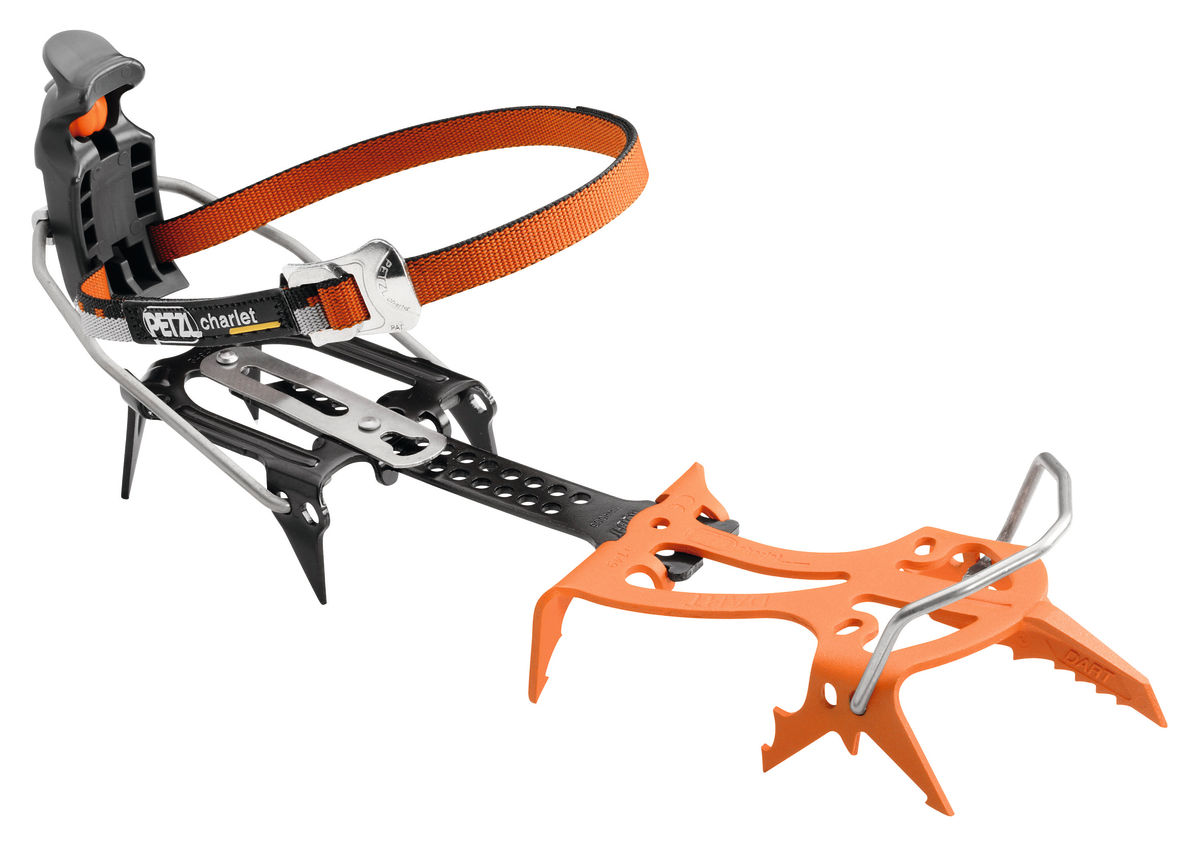
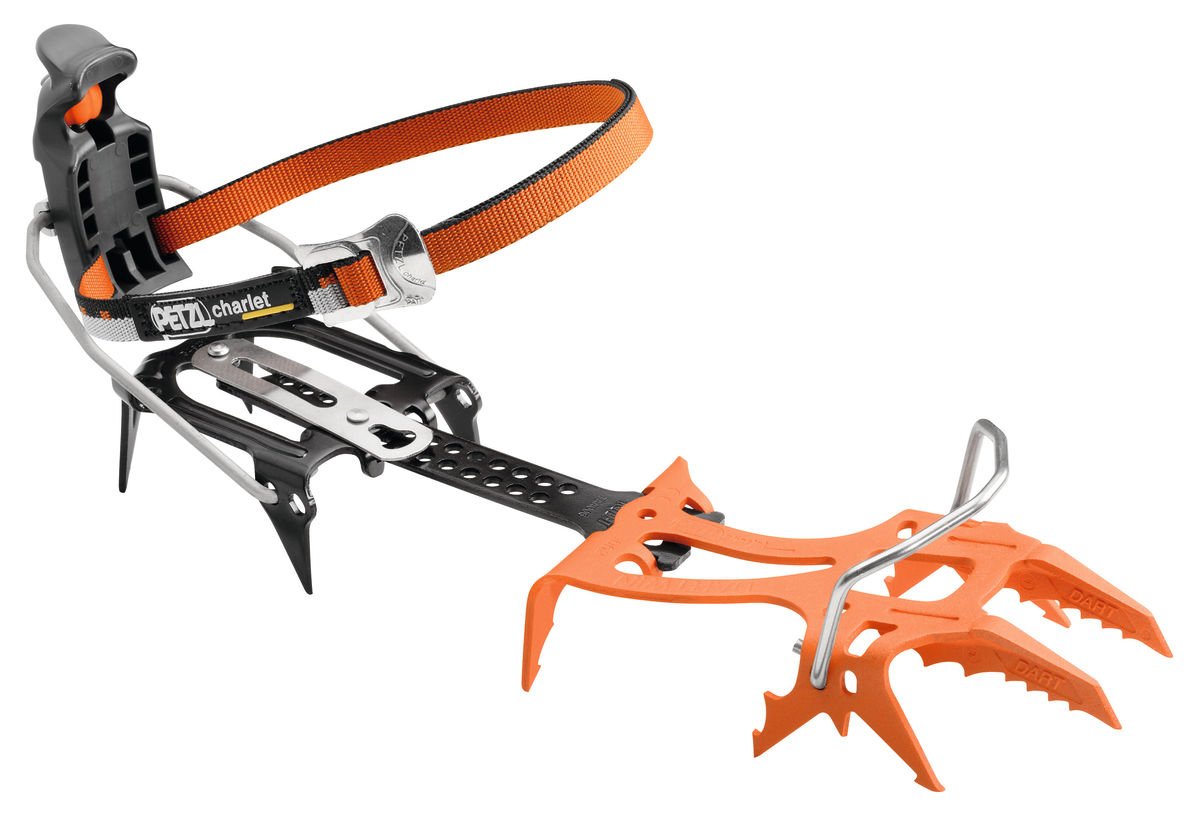
Monopoints VS Dualpoints
Keep your core warm.
The most common complaint I hear from less experienced ice climbers is, "My hands and feet get cold." They usually think thicker gloves or warmer boots will help, but what they really need to do is keep their core warm.
Most people don’t realize that body reduces circulation (warming blood) to the extremities (hands and feet) because it’s trying to keep the core vital organs warm; it’s the body’s version of survival mode. Before I started ice climbing I absolutely hated winter because my hands and feet were always cold. The truth was that I didn't know how to dress for the conditions. I have since climbed bare handed in -20 C.
You loose a lot of heat from the back of your neck so use high collared shirts and a hood. And make sure you dress in layers. Several close fitting layers trap more air and are warmer than one big thick layer. They also allow you to add and subtract insulation as the weather changes. You should also get a good belay jacket and a set of puffy pants that you can quickly and easily slip on when belaying. Make sure your boots fit properly. If they’re too tight, they’ll reduce circulation. On the other hand, if they’re too loose you’ll need to cinch them down extra-tight, which will also reduce circulation.
Don't sweat. If you get wet or damp you’ll get cold. If your activity increases and you start sweating, remove some clothing layers. If it’s a long hike to the cliff and you’re likely to sweat, pack an extra base layer for your upper torso. Once you arrive at the crag, quickly change into the dry top so you can stay warm.
Bring one set of warm gloves or mitts for belaying. You’ll want several pairs of thinner climbing gloves that you can swap out as they get wet throughout the day.
The most common complaint I hear from less experienced ice climbers is, "My hands and feet get cold." They usually think thicker gloves or warmer boots will help, but what they really need to do is keep their core warm.
Most people don’t realize that body reduces circulation (warming blood) to the extremities (hands and feet) because it’s trying to keep the core vital organs warm; it’s the body’s version of survival mode. Before I started ice climbing I absolutely hated winter because my hands and feet were always cold. The truth was that I didn't know how to dress for the conditions. I have since climbed bare handed in -20 C.
You loose a lot of heat from the back of your neck so use high collared shirts and a hood. And make sure you dress in layers. Several close fitting layers trap more air and are warmer than one big thick layer. They also allow you to add and subtract insulation as the weather changes. You should also get a good belay jacket and a set of puffy pants that you can quickly and easily slip on when belaying. Make sure your boots fit properly. If they’re too tight, they’ll reduce circulation. On the other hand, if they’re too loose you’ll need to cinch them down extra-tight, which will also reduce circulation.
Don't sweat. If you get wet or damp you’ll get cold. If your activity increases and you start sweating, remove some clothing layers. If it’s a long hike to the cliff and you’re likely to sweat, pack an extra base layer for your upper torso. Once you arrive at the crag, quickly change into the dry top so you can stay warm.
Bring one set of warm gloves or mitts for belaying. You’ll want several pairs of thinner climbing gloves that you can swap out as they get wet throughout the day.
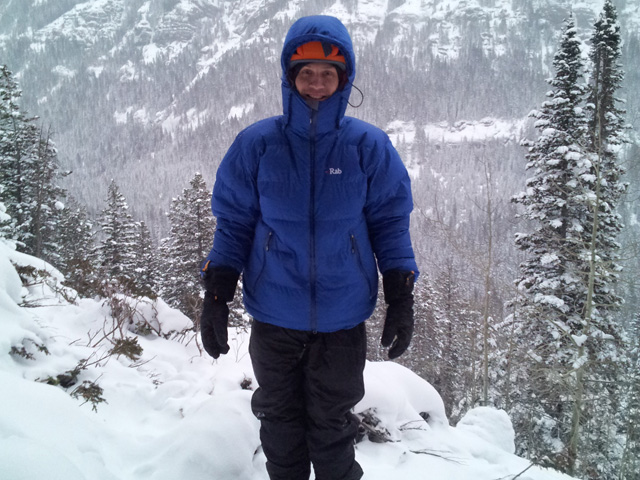
Dressed for belaying.
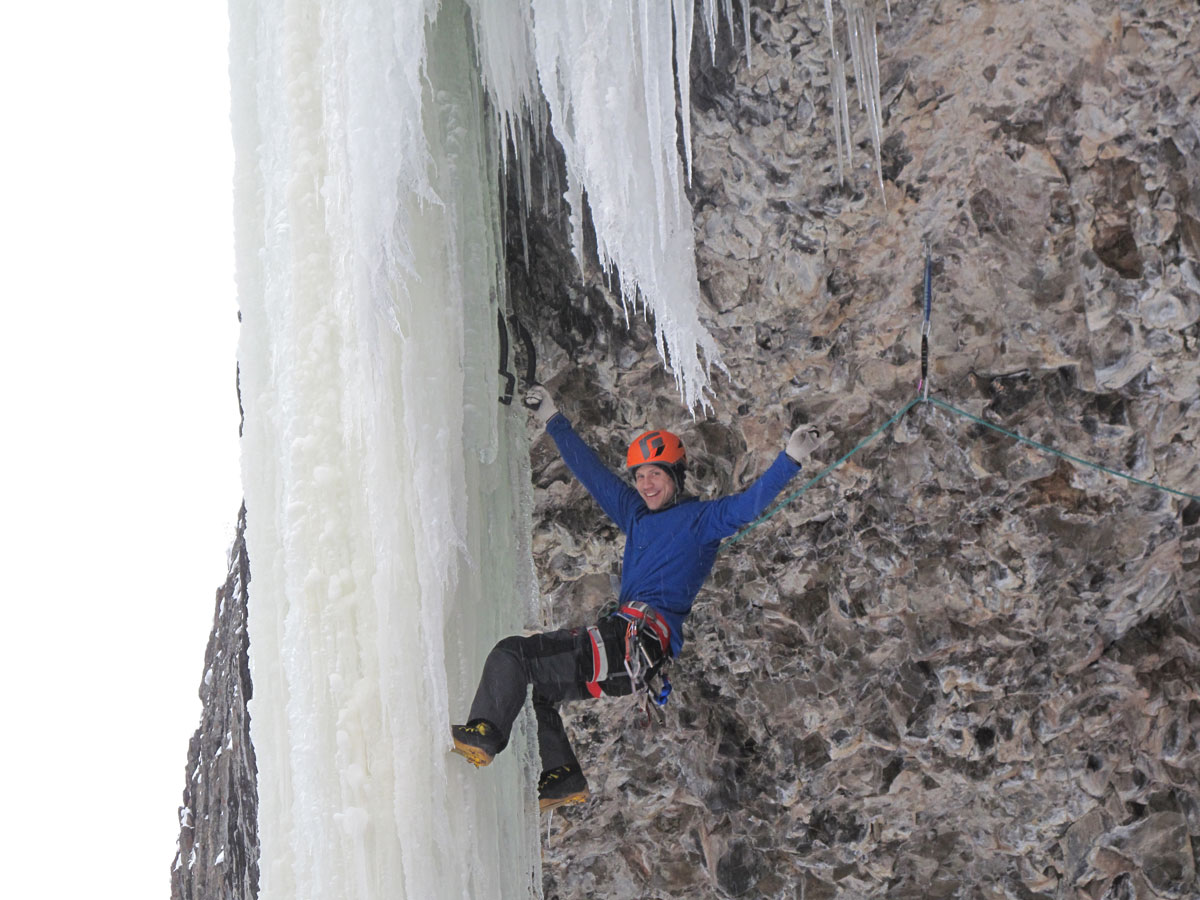
Stripped down for climbing.
Leashes are for dogs.
Back in the old days (less than 15 years ago) ice tools had straight shafts and no pinky rests, which made them very difficult to hold when climbing steep ice. Climbers added leashes to get around this gripping problem. While the leashes made it easier to hang on to the tools, they also reduced circulation to your hands, prevented you from shaking out, stopped you from matching hands when traversing and made it difficult to place screws. I could go on.
Using leashes with modern tools is a lot like keeping the training wheels on your mountain bike; they severely limit what you can do without adding any real benefits. Initially, leashless climbing will feel less secure, so practice on top rope until you’re comfortable. Once you learn to climb leashless, you’ll never go back.
If you’re concerned about dropping and losing a tool, there are several companies that make tethers specifically for this application. In reality you are probably far more likely to drop a leashed tool while placing a screw because of all the fumbling involved with clipping in and out of those manacles.
Back in the old days (less than 15 years ago) ice tools had straight shafts and no pinky rests, which made them very difficult to hold when climbing steep ice. Climbers added leashes to get around this gripping problem. While the leashes made it easier to hang on to the tools, they also reduced circulation to your hands, prevented you from shaking out, stopped you from matching hands when traversing and made it difficult to place screws. I could go on.
Using leashes with modern tools is a lot like keeping the training wheels on your mountain bike; they severely limit what you can do without adding any real benefits. Initially, leashless climbing will feel less secure, so practice on top rope until you’re comfortable. Once you learn to climb leashless, you’ll never go back.
If you’re concerned about dropping and losing a tool, there are several companies that make tethers specifically for this application. In reality you are probably far more likely to drop a leashed tool while placing a screw because of all the fumbling involved with clipping in and out of those manacles.

Leashes are for dogs. Woof!
